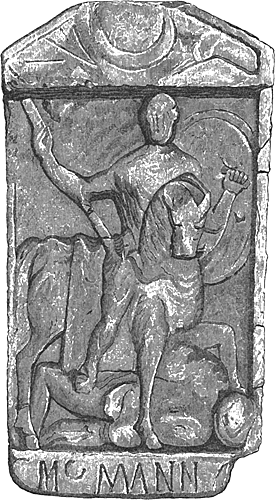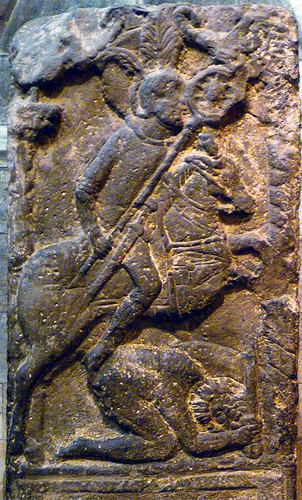
This page created 15 November 2015, and last modified: 1 December 2015 (Rivet & Smith reference added)

The thirteenth item listed (154.29 in Ingo Maier's numbering scheme) under the command of the Dux Britanniarum following the subsection headed "along the line of the Wall" (item 154.16, per lineam valli), is the Praefectus alae Petrianae Petrianis.
 Above: RIB 2030 from Stanwix. The deceased cavalryman is depicted in the stereotypical pose of riding over a barbarian footman, spear in hand. He carries large shield, either circular or oval; unfortunately, its face is not visible. Picture from an 1867 book. |
The identity of the prefect's unit, the ala Augusta Gallorum Petriana milliaria, is not in doubt, but the same cannot be said for the identity of the unit's station, Petrianis. This is clearly a doublet of the unit's moniker (taken from an equestrian officer named T. Pomponius Petra, who seems to have commanded the unit in the early 1st century), and of no help in identifying the place. Because the unit was the only milliaria-sized ala in Britain (although it was only normal-sized in the 1st century), it would have required an exceptionally large fort to hold it, and this has led most commentators to accept an equation of Petrianis with the fort, essentially un-excavated, in Stanwix in Cumbria, since this is indeed the largest fort along the line of the Wall.
There are some other points in favour of this identification. Firstly, tombstone from there (RIB 2030, see left) shows a cavalryman, as would be expected if it was garrisoned by an ala; unfortunately, it does not positively identify the man as a member of this unit (or any other, for that matter). Secondly, lead sealing (RIB 2411.84) has been found there that refers to the unit in the form ALP, for Ala Petriana. However, there is also one serious problem with the identification: Stanwix is accepted as being the Roman Uxelodunum, and in the Notitia, this is given as the location of another unit, the cohors I Hispanorum (154.32). If both units were regular-sized, one might easily accept that they might both have shared the site; however, not only was the ala Petriana an extra-sized milliaria unit, but so too was cohors I Hispanorum! It would appear that one of these two locations given in the Notitia must be in error. It is typically assumed that it is the cohors I Hispanorum location that is more likely to be in error, but I have my doubts about that... Shown right is a tombstone (RIB 1172) of a man who was definitely a member of the unit: Flavinus, who was a signifer; the standard he carries appears to an imago inside a circular case. The tombstone was found at the fort of Coria (modern Corbridge, Northumberland), and is now located 6 km to the west, in Hexham Abbey. No shield is depicted. |
 Above: RIB 1172, now located in Hexham Abbey. Photo by M.C. Bishop, and used under CCA 2.0 licence. |
As with all limitanei units in the Notitia, the shield pattern of the ala Petriana is not illustrated.
1. Ingo Maier; "Appendix 4: Numeration of the new edition of the compilation 'notitia dignitatum' (Cnd)"; last accessed 26 October 2015. See also for here for numbering examples. Return
2. E.g. Guy de la Bédoyère, "The Roman Army in Britain", last accessed 9 December 2015; and, more guardedly, M.C. Bishop, "The garrison: Part I", posted 2 August 2014, and last accessed 15 November 2015. Return
3. S.S. Frere, Margaret Roxan, & R.S.O. Tomlin (Eds); "The Roman Inscriptions of Britain", Vol. II, Fasc. I; Allan Sutton, Gloucester, 1990. Return
4. John Collingwood Bruce; "The Roman Wall: A Description of the Mural Barrier of the North of England", 3rd edition; Longmans, London (1867); at p 292; online version available here (last accessed 15 November 2015). Return
5. For example, A.L.F. Rivet & Colin Smith; "The Place-Names of Roman Britain"; Batsford, London, 1979; at p 221. Return

Return to the Notitia alphabetical unit list page.
Return to my Notitia index page.